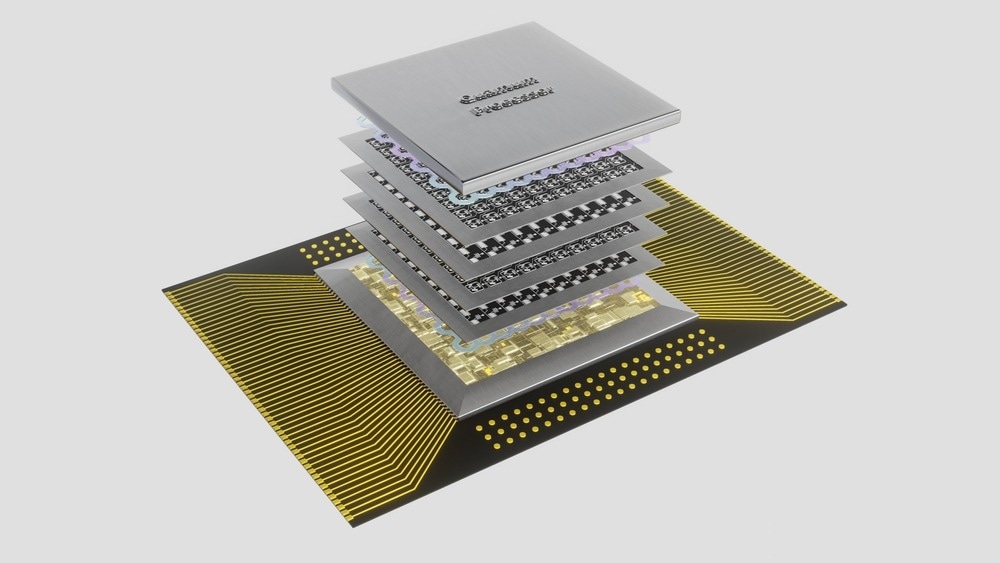A paper recently published in the journal Nature demonstrated non-Abelian braiding of graph vertices in a superconducting quantum processor for the first time by Google Quantum AI and collaborators.

Image Credit: atdigit/Shutterstock.com
The Importance of Non-Abelian Anyons
In quantum mechanics, the indistinguishability of particles is a fundamental principle that guarantees that the braiding of identical particles, including elementary and quasiparticles such as Abelian anyons, bosons, and fermions, does not lead to changes in the system.
However, the braiding of non-Abelian anyons in two spatial dimensions can lead to rotations in a space of topologically degenerate wavefunctions, which can change the system observables without violating the indistinguishability principle.
The topological quantum computation approach aims to leverage the non-Abelian anyons and their topological nature to enable gate operations protected against decoherence errors and local perturbations.
Non-Abelian anyons possess a unique capability of retaining a sort of memory, which enables the determination of their exchange statistics. Thus, these anyons have the potential to transform quantum computing by making the operations more robust to noise.
In solid-state systems, the primary non-Abelian quasiparticle candidates are low energy excitations in Hamiltonian systems, including vortices in topological superconductors, superconductor-proximitized Majorana zero modes in semiconductors, and 5/2 fractional quantum Hall states.
Although a mathematical description of non-Abelian anyons has been developed, direct verification/experimental observation of non-Abelian exchange statistics has not been achieved until now. Quantum processor-generated controllable many-body quantum states offer an alternative way to explore these fundamental phenomena.
Observation efforts on conventional solid-state platforms involve Hamiltonian dynamics of quasiparticles. However, superconducting quantum processors allow direct manipulation of many-body wavefunction through unitary gates.
Quantum processors allow controlled unitary evolution and direct access to the wave function. These features enable the use of local operations for effective preparation of topological states that can host non-Abelian anyons, and their subsequent braiding and fusion.
Moreover, quantum processors also allow the observation of arbitrary Pauli strings through destructive multiqubit measurements. Anyons are not quasiparticles in this platform as the braiding of non-Abelian anyons is achieved through unitary gate control in place of adiabatic Hamiltonian system evolution.
The movement of anyons is realized through local operations along their paths, and all anyons are kept separated spatially throughout the braiding. Thus, two-dimensional (2D) braiding processes are occurring on the quantum processor, which leads to actual non-Abelian exchange effects of local anyons in the many-body wavefunction.
Non-Abelian Braiding in a Superconducting Quantum Processor
In this study, researchers at Google Quantum AI implemented a generalized stabilizer code and unitary protocol to create and braid projective non-Abelian Ising anyons based on the predictions that stabilizer codes can host such anyons using their superconducting quantum processors.
The approach allowed researchers to verify the fusion rules of anyons and braid them to realize their exchange statistics. Additionally, researchers also evaluated the feasibility of using non-Abelian anyons for quantum computation and using braiding to create an entangled anyon state encoding three logical qubits.
Initially, superconducting qubits were prepared in an entangled quantum state that was represented as a checkerboard. Abelian anyons emerged in the checkerboard arrangement.
Researchers squashed and stretched the quantum state of their qubits to transform the checkered pattern into oddly-shaped polygons. Non-Abelian anyons were hosted by particular vertices in these polygons. The non-Abelian anyons were then moved around by deforming the lattice and shifting the locations of non-Abelian vertices.
Subsequently, several experiments were performed to observe the behavior of non-Abelian anyons and their way of interacting with Abelian anyons. Eventually, researchers investigated the ways through which the braiding of non-Abelian anyons can be sued for quantum computations.
Significance of the Study
Highly controllable braiding of degree-3 vertices was realized successfully, enabling the demonstration of the braiding and fusion rules of non-Abelian Ising anyons. Researchers also displayed the feasibility of using braiding to create an entangled state of three logical qubits in these non-Abelian anyons.
A well-known quantum entangled state, referred to as the Greenberger-Horne-Zeilinger (GHZ) state, was created by braiding together several non-Abelian anyons.
Weaving the Abelian and non-Abelian particles around one another led to peculiar phenomena where particles mysteriously reappeared, disappeared, and shapeshifted from one type to another as they wound around and collided.
Additionally, the exchanging/swapping of non-Abelian anyons resulted in a measurable change in the quantum state of their system. This phenomenon was witnessed for the first time by the researchers.
In conventional platforms for non-Abelian exchange statistics that involve Hamiltonian dynamics of quasi-particle excitations, the topological protection emerges from an emergent gap separating the computational states from other states.
However, stabilizers were used throughout the braiding protocol to leverage non-Abelian anyons in superconducting quantum processors for topologically protected quantum computing.
This error correction procedure that involves overheads, including a readout of five-qubit stabilizers, can be used to realize the fault-tolerant implementation of Clifford gates, a critical ingredient of universal quantum computation.
To summarize, the results of this study paved the way for topological quantum computation, in which computing operations can be achieved by winding non-Abelian anyons around each other.
More from AZoQuantum: Scientists Present a New Quantum Repeater Node for a Quantum Internet
References and Further Readings
Google Quantum AI and Collaborators. (2023) Non-Abelian braiding of graph vertices in a superconducting processor. Nature. https://doi.org/10.1038/s41586-023-05954-4
Google Quantum AI Braids Non-Abelian Anyons – A Breakthrough That Could Revolutionize Quantum Computing [Online] Available at https://scitechdaily.com/google-quantum-ai-braids-non-abelian-anyons-a-breakthrough-that-could-revolutionize-quantum-computing/?utm_content=cmp-true (Accessed on 18 May 2023)
Nayak, C., Simon, S. H., Stern, A., Freedman, M., Sarma, S. D. (2007). Non-Abelian anyons and topological quantum computation. Reviews of Modern Physics, 80, 1083–1159. https://www.researchgate.net/publication/1898420_Non-Abelian_Anyons_and_Topological_Quantum_Computatio
Disclaimer: The views expressed here are those of the author expressed in their private capacity and do not necessarily represent the views of AZoM.com Limited T/A AZoNetwork the owner and operator of this website. This disclaimer forms part of the Terms and conditions of use of this website.